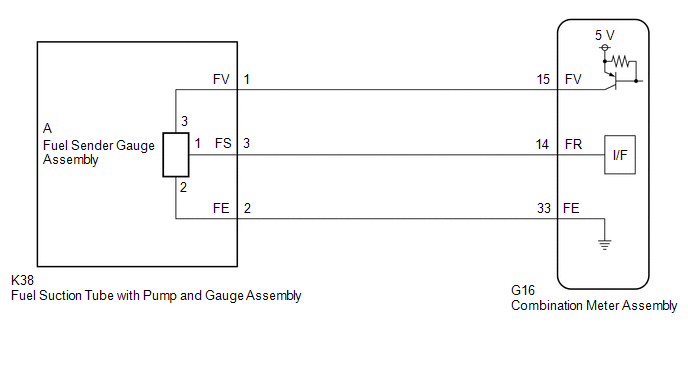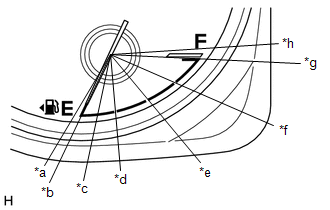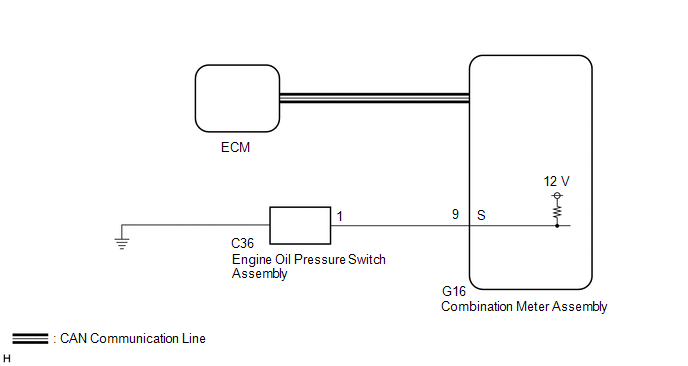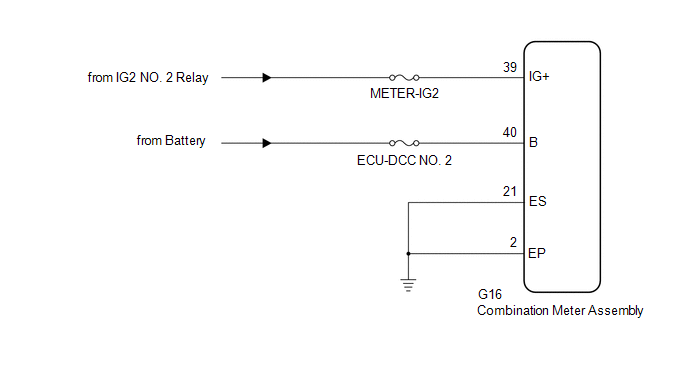Fuel Receiver Gauge Display Malfunction
DESCRIPTION
FUEL RECEIVER GAUGE OPERATION
(a) OPERATION
The
combination meter assembly uses the fuel sender gauge assembly to
detect the amount of fuel remaining in the fuel tank assembly. The Hall
IC built into the fuel sender gauge assembly changes the output voltage
according to the amount of fuel remaining. The combination meter
assembly receives fuel injection volume signals from the ECM and detects
the voltage output from the fuel sender gauge assembly and operates the
fuel receiver gauge.
FUEL RECEIVER GAUGE READING
(a) During normal driving:
As
the fuel level in the fuel tank assembly changes when driving on a hill
or applying the brakes, the fuel receiver gauge reading is updated
according to the fuel injection volume during normal driving. However,
as the fuel injection volume measurement has a margin of error, the
value is indicated after correction by input values from the fuel sender
gauge assembly.
(b) During refueling:
The
fuel level in the fuel tank assembly rises rapidly when fuel is added.
If the averaging process that is used during normal driving is used in
this case, the fuel receiver gauge reading cannot be updated promptly.
Therefore, when it is judged that fuel is being added to the vehicle
based on the changes in the fuel level, output values from the fuel
sender gauge assembly is immediately reflected in the fuel receiver
gauge reading. This control is called refueling judgment.
NOTICE:
Add
fuel with the engine switch off to ensure safety and to enable
refueling judgment so that an appropriate fuel receiver gauge reading
will be obtained.
REFUELING JUDGMENT CONDITIONS
(a) Normal judgment condition (When normal refueling method is used)
With
the engine switch off, the fuel sender gauge assembly detects a change
of 5.0 liters (5.3 US qts, 4.4 Imp. qts) or more in the fuel level.
(b) Other judgment conditions (When other refueling method is used)
Any of the following conditions is met:
- With the vehicle and engine stopped and the engine switch on (IG), the
fuel sender gauge assembly detects a change of 5.0 liters (5.3 US qts,
4.4 Imp. qts) or more in the fuel level.
- With the vehicle stopped, the engine switch is on (IG), the fuel sender
gauge assembly detects a change of 15.0 liters (15.9 US qts, 13.2 Imp.
qts) or more in the fuel level.
PRECAUTION FOR REFUELING
(a)
The fuel sender gauge assembly cannot detect changes in the fuel level
within certain ranges (around points E and F). Therefore, even if 5.0
liters (5.3 US qts, 4.4 Imp. qts) or more of fuel is added, refueling
judgment may not be performed and the fuel receiver gauge reading may
not change when fuel level is within such ranges.
(b)
The fuel sender gauge reading takes approximately 25 seconds to rise
from point E to F. If the vehicle is driven while the fuel sender gauge
reading is rising, the fuel sender gauge reading will stop rising. After
the fuel sender gauge reading stops rising, normal fuel sender gauge
reading operation begins. The fuel sender gauge reading takes
approximately 1 minutes per 1 liter (1.1 US qts, 0.9 Imp. qts) to rise
while the vehicle is being driven, and takes approximately 8 minutes per
1 liter (1.1 US qts, 0.9 Imp. qts) to rise while the vehicle is
stopped.
FORCED RESET OF FUEL RECEIVER GAUGE
When
driving at a vehicle speed of 1.8 km/h (1 mph) or more, if the output
value from the fuel sender gauge assembly is different from the fuel
receiver gauge reading by 15.0 liters (15.9 US qts, 13.2 Imp. qts) or
more for approximately 5 minutes, the output value from the fuel sender
gauge assembly is immediately reflected in the fuel receiver gauge
reading to compensate for a situation when refueling judgment cannot be
made.
WIRING DIAGRAM

CAUTION / NOTICE / HINT
NOTICE:
When
replacing the combination meter assembly, always replace it with a new
one. If a combination meter assembly which was installed to another
vehicle is used, the information stored in it will not match the
information from the vehicle and a DTC may be stored.
HINT:
- The fuel level warning light will come on when the fuel level is below 9.1 liter (9.6 US qts, 8.0 Imp. qts).*1
- The fuel level warning light will come on when the fuel level is below 8.3 liter (8.8 US qts, 7.3 Imp. qts).*2
- *1: for Fuel Tank 60.6 liter (64.0 US qts, 53.3 Imp. qts)
- *2: for Fuel Tank 55.0 liter (58.1 US qts, 48.4 Imp. qts)
PROCEDURE
|
1. | CHECK FOR DTC (SFI SYSTEM) |
(a) Check if SFI system DTCs are output.
Powertrain > Engine > Trouble Codes
|
Result | Proceed to |
|
DTCs are not output | A |
|
DTCs are output | B |
| B |
 | GO TO SFI SYSTEM |
|
A |
 | |
| 2. |
CHECK FOR DTC (ELECTRONICALLY CONTROLLED BRAKE SYSTEM) |
(a) Check if electronically controlled brake system DTCs are output.
Chassis > ABS/VSC/TRAC/EPB > Trouble Codes
|
Result | Proceed to |
|
DTCs are not output | A |
|
DTCs are output | B |
| B |
 | GO TO ELECTRONICALLY CONTROLLED BRAKE SYSTEM |
|
A |
 | |
| 3. |
CHECK FOR DTC (METER / GAUGE SYSTEM) |
(a) Check if meter / gauge system DTCs are output.
Body Electrical > Combination Meter > Trouble Codes
|
Result | Proceed to |
|
DTC B150013 is not output |
A |
| DTC B150013 is output |
B |
| B |
 | GO TO B150013 |
|
A |
 | |
(a) Ask the customer about the problem symptoms.
|
Result | Proceed to |
|
Malfunction occurs when adding fuel (Even after adding fuel, reading does not increase at all or increases very slowly, etc.) |
A |
| Malfunction
occurs during normal driving (The reading does not change, decreases
quickly or decreases when the vehicle is not being driven, etc.) (The
problem symptom recurs) | B |
|
Malfunction
occurs during normal driving (The reading does not change, decreases
quickly or decreases when the vehicle is not being driven, etc.) (The
problem symptom does not recur) |
C |
| B |
 | GO TO STEP 8 |
| C |
 | GO TO STEP 10 |
|
A |
 | |
| 5. |
PERFORM ACTIVE TEST USING TECHSTREAM |

|
*a | Fuel Gauge Operation (Sender E) |
|
*b | Fuel Gauge Operation (Empty) |
|
*c | Fuel Gauge Operation (Warning) |
|
*d | Fuel Gauge Operation (1/4) |
|
*e | Fuel Gauge Operation (1/2) |
|
*f | Fuel Gauge Operation (3/4) |
|
*g | Fuel Gauge Operation (Full) |
|
*h | Fuel Gauge Operation (Sender F) |
(a) Connect the Techstream to the DLC3.
(b) Turn the engine switch on (IG).
(c) Turn the Techstream on.
(d) Enter following menus: Body Electrical / Combination Meter / Active Test.
(e) Perform the Active Test according to the display on the Techstream.
Body Electrical > Combination Meter > Active Test
|
Tester Display | Measurement Item |
Control Range | Diagnostic Note |
|
Fuel Gauge Operation (Sender E) |
Fuel receiver gauge (Sender E) |
ON | - |
|
Fuel Gauge Operation (Empty) |
Fuel receiver gauge (Empty) |
ON | - |
|
Fuel Gauge Operation (Warning) |
Fuel receiver gauge (Warning) |
ON | - |
|
Fuel Gauge Operation (1/4) |
Fuel receiver gauge (1/4) |
ON | - |
|
Fuel Gauge Operation (1/2) |
Fuel receiver gauge (1/2) |
ON | - |
|
Fuel Gauge Operation (3/4) |
Fuel receiver gauge (3/4) |
ON | - |
|
Fuel Gauge Operation (Full) |
Fuel receiver gauge (Full) |
ON | - |
|
Fuel Gauge Operation (Sender F) |
Fuel receiver gauge (Sender F) |
ON | - |
Body Electrical > Combination Meter > Active Test
|
Tester Display |
| Fuel Gauge Operation (Sender E) |
Body Electrical > Combination Meter > Active Test
|
Tester Display |
| Fuel Gauge Operation (Empty) |
Body Electrical > Combination Meter > Active Test
|
Tester Display |
| Fuel Gauge Operation (Warning) |
Body Electrical > Combination Meter > Active Test
|
Tester Display |
| Fuel Gauge Operation (1/4) |
Body Electrical > Combination Meter > Active Test
|
Tester Display |
| Fuel Gauge Operation (1/2) |
Body Electrical > Combination Meter > Active Test
|
Tester Display |
| Fuel Gauge Operation (3/4) |
Body Electrical > Combination Meter > Active Test
|
Tester Display |
| Fuel Gauge Operation (Full) |
Body Electrical > Combination Meter > Active Test
|
Tester Display |
| Fuel Gauge Operation (Sender F) |
OK:
Fuel receiver gauge indication is normal.
| NG |
 | REPLACE COMBINATION METER ASSEMBLY |
|
OK |
 | |
| 6. |
CHECK FUEL RECEIVER GAUGE OPERATION BY ADDING FUEL |
(a) Record the fuel receiver gauge reading.
(b)
If the fuel tank assembly is almost full, drain 20 liters (21.1 US qts,
17.6 Imp. qts) or more of fuel. (This is not necessary when the fuel
tank assembly is sufficiently below full.)
(c) Disconnect the cable from the negative (-) battery terminal to reset the fuel receiver gauge.
NOTICE:
Make sure that the engine switch is off before disconnecting the cable from the negative (-) battery terminal.
(d) Connect the cable to the negative (-) battery terminal and turn the engine switch on (IG).
(e) Check that the fuel receiver gauge has been reset.
(f) Drive the vehicle at 1.8 km/h (1 mph) or more, then move the shift lever to P and turn the engine switch off.
(g)
Add 5.0 liters (5.3 US qts, 4.4 Imp. qts) or more of fuel, turn the
engine switch on (IG), and check that the fuel receiver gauge reading
increases in proportion to the amount of fuel added.
|
Result | Proceed to |
|
Fuel receiver gauge reading increases in proportion to the amount of fuel added |
A |
| Fuel receiver gauge reading does not change even when fuel is added |
B |
| B |
 | REPLACE COMBINATION METER ASSEMBLY |
|
A |
 | |
| 7. |
INSPECT FUEL TANK ASSEMBLY |
HINT:
Inspect
the fuel tank assembly for deformation, foreign matter or an improperly
installed fuel receiver gauge, as this may be the cause of the fuel
receiver gauge malfunction.
(a) Visually check the fuel tank assembly for any abnormalities.
(b) Check if there is an excessive amount of foreign matter in the fuel tank assembly.
(c) Check the installation condition of the fuel tank assembly and fuel sender gauge assembly.
|
Result | Proceed to |
|
Normal | A |
|
Appearance of the fuel tank assembly is abnormal |
B |
| There is an excessive amount of foreign matter in the fuel tank assembly |
C |
| The fuel tank assembly or fuel sender gauge assembly is not installed correctly |
D |
| A |
 | REPLACE COMBINATION METER ASSEMBLY |
| B |
 | REPLACE FUEL TANK ASSEMBLY |
| C |
 | CLEAN INSIDE OF FUEL TANK ASSEMBLY |
| D |
 | INSTALL FUEL TANK ASSEMBLY OR FUEL SENDER GAUGE ASSEMBLY CORRECTLY |
| 8. |
PERFORM ACTIVE TEST USING TECHSTREAM |

|
*a | Fuel Gauge Operation (Sender E) |
|
*b | Fuel Gauge Operation (Empty) |
|
*c | Fuel Gauge Operation (Warning) |
|
*d | Fuel Gauge Operation (1/4) |
|
*e | Fuel Gauge Operation (1/2) |
|
*f | Fuel Gauge Operation (3/4) |
|
*g | Fuel Gauge Operation (Full) |
|
*h | Fuel Gauge Operation (Sender F) |
(a) Connect the Techstream to the DLC3.
(b) Turn the engine switch on (IG).
(c) Turn the Techstream on.
(d) Enter following menus: Body Electrical / Combination Meter / Active Test.
(e) Perform the Active Test according to the display on the Techstream.
Body Electrical > Combination Meter > Active Test
|
Tester Display | Measurement Item |
Control Range | Diagnostic Note |
|
Fuel Gauge Operation (Sender E) |
Fuel receiver gauge (Sender E) |
ON | - |
|
Fuel Gauge Operation (Empty) |
Fuel receiver gauge (Empty) |
ON | - |
|
Fuel Gauge Operation (Warning) |
Fuel receiver gauge (Warning) |
ON | - |
|
Fuel Gauge Operation (1/4) |
Fuel receiver gauge (1/4) |
ON | - |
|
Fuel Gauge Operation (1/2) |
Fuel receiver gauge (1/2) |
ON | - |
|
Fuel Gauge Operation (3/4) |
Fuel receiver gauge (3/4) |
ON | - |
|
Fuel Gauge Operation (Full) |
Fuel receiver gauge (Full) |
ON | - |
|
Fuel Gauge Operation (Sender F) |
Fuel receiver gauge (Sender F) |
ON | - |
Body Electrical > Combination Meter > Active Test
|
Tester Display |
| Fuel Gauge Operation (Sender E) |
Body Electrical > Combination Meter > Active Test
|
Tester Display |
| Fuel Gauge Operation (Empty) |
Body Electrical > Combination Meter > Active Test
|
Tester Display |
| Fuel Gauge Operation (Warning) |
Body Electrical > Combination Meter > Active Test
|
Tester Display |
| Fuel Gauge Operation (1/4) |
Body Electrical > Combination Meter > Active Test
|
Tester Display |
| Fuel Gauge Operation (1/2) |
Body Electrical > Combination Meter > Active Test
|
Tester Display |
| Fuel Gauge Operation (3/4) |
Body Electrical > Combination Meter > Active Test
|
Tester Display |
| Fuel Gauge Operation (Full) |
Body Electrical > Combination Meter > Active Test
|
Tester Display |
| Fuel Gauge Operation (Sender F) |
OK:
Fuel receiver gauge indication is normal.
| NG |
 | REPLACE COMBINATION METER ASSEMBLY |
|
OK |
 | |
| 9. |
INSPECT FUEL RECEIVER GAUGE |
(a) Disconnect the cable from the negative (-) battery terminal to reset the fuel receiver gauge.
NOTICE:
Make sure that the engine switch is off before disconnecting the cable from the negative (-) battery terminal.
(b) Connect the cable to the negative (-) battery terminal and turn the engine switch on (IG).
(c) Check if the fuel receiver gauge reading corresponds with the amount of fuel remaining in the fuel tank assembly.
|
Result | Proceed to |
|
Fuel receiver gauge reading corresponds with the amount of fuel remaining in the fuel tank assembly |
A |
| Fuel receiver gauge reading does not correspond with the amount of fuel remaining in the fuel tank assembly |
B |
| A |
 | END |
| B |
 | REPLACE COMBINATION METER ASSEMBLY |
| 10. |
INSPECT FUEL TANK ASSEMBLY |
HINT:
Inspect
the fuel tank assembly for deformation, foreign matter or an improperly
installed fuel receiver gauge, as this may be the cause of the fuel
receiver gauge malfunction.
(a) Visually check the fuel tank assembly for any abnormalities.
(b) Check if there is an excessive amount of foreign matter in the fuel tank assembly.
(c) Check the installation condition of the fuel tank assembly and fuel sender gauge assembly.
|
Result | Proceed to |
|
Normal | A |
|
Appearance of the fuel tank assembly is abnormal |
B |
| There is an excessive amount of foreign matter in the fuel tank assembly |
C |
| The fuel tank assembly or fuel sender gauge assembly is not installed correctly |
D |
| A |
 | REPLACE COMBINATION METER ASSEMBLY |
| B |
 | REPLACE FUEL TANK ASSEMBLY |
| C |
 | CLEAN INSIDE OF FUEL TANK ASSEMBLY |
| D |
 | INSTALL FUEL TANK ASSEMBLY OR FUEL SENDER GAUGE ASSEMBLY CORRECTLY |





































